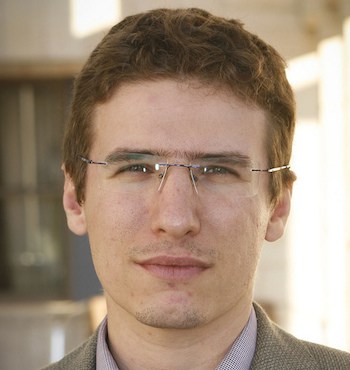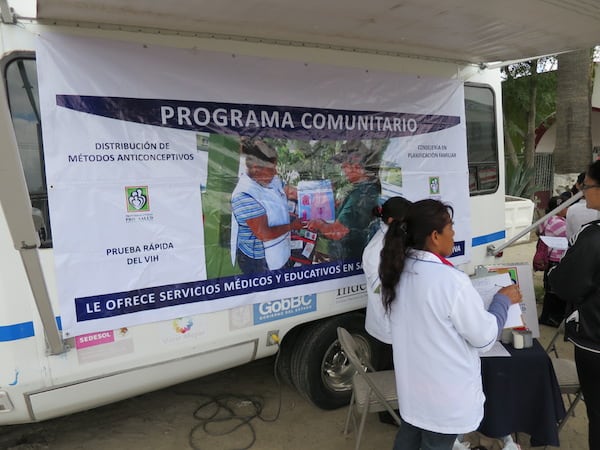MobileODT’s Goal: Making Cervical Cancer Screening Available to Every Woman, Everywhere – at a Profit
Cervical cancer is a leading cause of death worldwide, but most of the deaths could be prevented through early detection. MobileODT has developed a low-cost colposcope that uses smartphones to replace more complex and expensive cervical screening systems. Here, CEO and co-founder Ariel Beery talks about the tool itself, called the Enhanced Visual Assessment (or EVA) System, and his company’s plans to reach billions of people in both developed and developing countries.
Kyle Poplin: What is MobileODT’s mission?
 Ariel Beery (left): To provide a medical device-based digital platform for health workers to reach the 5.8 billion people around the world who can access phones but not physicians. Each and every person on the planet goes to see a health provider when they or their loved ones are ill, yet many of those health providers lack the equipment and the expertise to provide a timely diagnosis and accurate treatment. MobileODT addresses that gap by building affordable, mobile medical equipment that has powerful algorithmic expertise to help health providers conduct lifesaving examinations, and native networking capabilities to enable that health provider to connect with expert clinicians to receive advice and connect with others who can provide quality care if it is lacking locally.
Ariel Beery (left): To provide a medical device-based digital platform for health workers to reach the 5.8 billion people around the world who can access phones but not physicians. Each and every person on the planet goes to see a health provider when they or their loved ones are ill, yet many of those health providers lack the equipment and the expertise to provide a timely diagnosis and accurate treatment. MobileODT addresses that gap by building affordable, mobile medical equipment that has powerful algorithmic expertise to help health providers conduct lifesaving examinations, and native networking capabilities to enable that health provider to connect with expert clinicians to receive advice and connect with others who can provide quality care if it is lacking locally.
KP: How big a problem is cervical cancer in the developing world?
AB: With 528,000 new cases each year and over 250,000 deaths, cervical cancer is the fourth most common cancer in women worldwide and the most common cancer in many low- and middle-income countries. It is estimated that 84 percent of cervical cancer cases occur in less developed countries, where cervical cancer diagnostic screening and prevention methods are limited. Deaths due to cervical cancer are largely preventable and can tragically strike during the middle of a woman’s most productive years, and when she has young children and growing families who depend on her.
KP: Describe MobileODT’s colposcope and how it works (in layman’s terms).
AB: The EVA System, our connected colposcope, works at the point of care to conduct a colposcopy in any setting. In its simplest form, a health provider securely logs into our application on the smartphone connected to the colposcope when seeing a patient, enters the patient’s information (name, ID number, phone number, location and a whole host of other fields), visualizes the patient in the visualization screen and captures images just like you would capture images on any smartphone, and then is guided through a decision aid to make a diagnosis and document any referral or follow-up a woman may need. If the provider needs further support, they are able to ask for consultation from a licensed person in their network with the simple click of a button. At this point, the health provider is able to use the images captured during the session to show the patient her cervix and provide patient education, something that has never been able to be done before. The key value MobileODT’s EVA System brings to any health system is it enables field-based providers at the point of care to bring a powerful, affordable visualization tool with them, wherever they go, and use it to leverage the worldwide network of expertise that can help them provide the patient with the best possible plan for care.
KP: What advantages does it offer over traditional cervical screening systems?
AB: Lack of infrastructure and shortage of experts make standard cervical cancer screening (Pap and HPV testing) inaccessible to many women. For this reason, an alternative screening approach developed to address these challenges was developed called Visual Assessment with Acetic Acid (VIA), a method in which a nurse or midwife applies a diluted acetic acid solution (3 percent to 5 percent white vinegar) to a patient’s cervix and visualizes it from outside the vaginal canal with the naked eye. Pre-cancerous and cancerous lesions turn white after a few minutes of applying the acetic acid, and can be identified by trained health care providers. Today VIA is practiced by health providers in over 70 countries around the world, and has been studied and debated extensively as a low-cost screening alternative. Nevertheless, while VIA expands access to screening, VIA programs face several challenges mainly resulting from the difficulty of providing quality clinical supervision to nurses and midwives performing the examination. VIA suffers from a positive predictive value of only 17 percent – approximately five of six positive diagnoses are false. This leads to misdiagnosis, costing under-resourced health systems money in cases of over-diagnosis and leading to untimely death in cases of under-diagnosis.
The EVA System enables health care providers to better visualize the cervix with a consistent light source, at magnification. The mHealth component then allows supervisors to provide remote consultation on specific cases and to conduct ongoing quality assurance checks to ensure women are being accurately screened and treated. The EVA System does this all while still maintaining low costs.

A mobile clinic in Baja, Calif., uses the EVA System to offer women health care services. This effort is led by Fronteras Unidas ProSalud’s Outreach Program.
KP: Where is the colposcope currently in use and what are MobileODT’s plans for expansion?
AB: The EVA System is currently in use across 22 countries, on the African continent, Central Asia, India and in the United States of America. Our focus is to provide tools for health providers across the world in low-resource settings. In 2017 we are focusing on working with health providers across the U.S., to enable them to strengthen their ability to care for patients in low-resource settings, and in India, to pilot new approaches to expanding cervical cancer screening to all of India’s women. In 2018 we will continue east, to China and Southeast Asia.
KP: MobileODT seeks solutions for low-resource settings. Could you briefly discuss your business model and scalability, including any plans to introduce the colposcope in the developed world?
AB: The sad reality is that low-resource settings exist across the world, even in what we think as the “developed world.” Across America, for example, there are low-resource settings where cervical cancer is as prevalent as in areas of South Africa. MobileODT’s business model was built to enable health providers across all of the world’s low-resource settings to serve their patient populations in an affordable manner. Our EVA mobile colposcope is priced at a fraction of the price of a traditional colposcope, making it affordable also for the purpose of digital cervicography. We then enable health systems and clinical networks to subscribe to additional digital tools and services – including quality assurance, multi-party secure collaboration, M&E analytics and reporting, and patient tracking – to enhance their capacity without ballooning overhead.
KP: MobileODT won the Vodafone Americas Foundation’s Wireless Innovation Project in 2014 and a $300,000 grant. How important was that money to the project and how motivating was that win to those who worked on the project?
AB: At the time of the Vodafone Americas Foundation Wireless Innovation Project, the company had plans in place to field test the device to help detect early signs of cervical cancer for a clinic in Mexico. After the competition, MobileODT piloted the mobile colposcope in five countries with partner organizations including ProSalud and Scripps. The other countries include Haiti with Partners in Health, Kenya with the Global Health Group of MassGeneral Hospital, Botswana with the Botswana-UPenn Partnership, and the U.S. with Scripps.
Two trials have been funded with the money: a non-inferiority trial comparing images taken with a standard colposcope and the MobileODT EVA System; and a usability trial completed by the Scripps Clinic – a true milestone toward FDA approval.
As of November, we have begun manufacturing our first batch of mobile colposcopes, and will begin sales in December.
(Editor’s note: Submissions for Vodafone Americas Foundation’s Wireless Innovation Project are still open.)
KP: At what point did you realize that the colposcope was filling a need and that your concept was valid?
AB: In June of 2014 we saw the first prototype of the EVA mobile colposcope in use in Haiti, and realized that we had the opportunity to transform access to care for billions of women around the world. We were in a clinic in Cange, where the supervising gynecologist had to drive for two hours to work with a long line of patients who had come in the night before to wait for him. In the middle of the second examination the electricity died – and instinctively the gynecologist put down the colposcope to say he had to wait until the electricity returned. That is, until he looked down and saw that the mobile colposcope, being battery powered, could still function – and the software, also battery powered, had not skipped a beat. At that moment we knew that no matter where our EVA System went, it could be used independently of local infrastructure – for viewing, as well as seeking support from remote clinicians. That meant that no woman would be too remote to be screened for cervical cancer.
KP: What are some of your goals as a company? How will you know when you’ve become successful?
AB: Our goal is to build a billion-dollar business that radically improves health care for billions of people. We are doing so by building technology that is used to save as many lives as quickly as possible. We will know we are successful when cervical cancer and other highly preventable diseases which are visually assessable become diseases of the past, and every woman, everywhere, has access to cervical cancer screening.
KP: What have been the most pleasant surprises you’ve encountered in your pursuit of health solutions in the developing world?
AB: We have been most surprised by the culture of partnership and mutual support which has made it possible for us to learn from the world’s greatest experts and build tools that meet their needs.
KP: What have been the biggest challenges?
AB: Financing has been our greatest challenge. At first, the investor community was wary about investing in a company that focuses on low-resource settings worldwide. Once we achieved FDA clearance and had significant sales into the U.S. market, that reluctance was reduced.
Kyle Poplin is the editor of NextBillion Health Care.
Photos courtesy of MobileODT
- Categories
- Health Care



